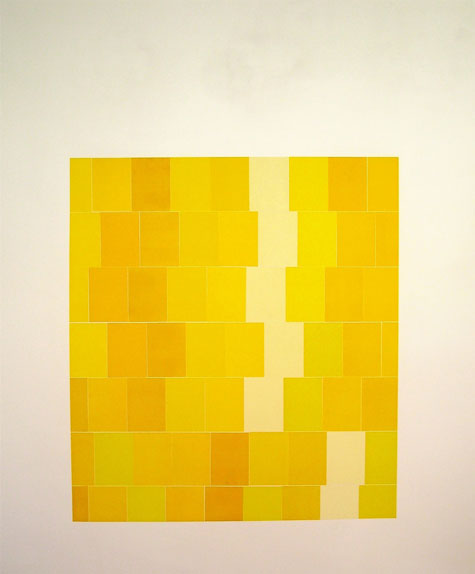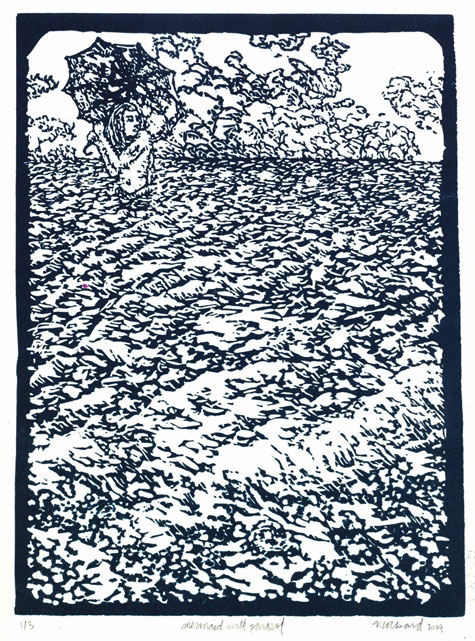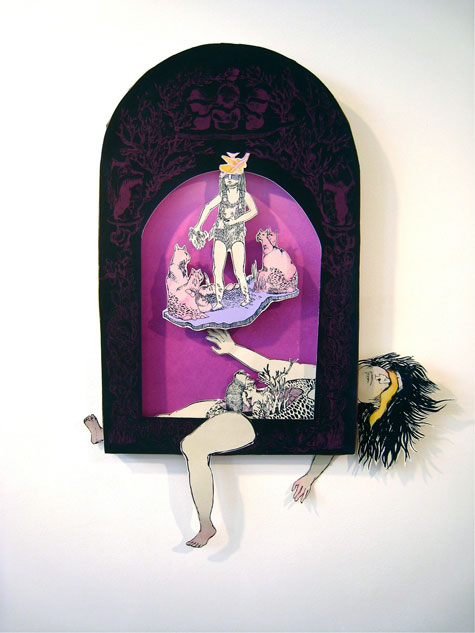
A CATCHY RHYTHM Michalowska's favorite shades of yellow. |
Meg Turner steals the show in 5 Traverse gallery's new exhibit with her installation Santa's Worst Nightmare. Climb up a few stairs, step into a closet-sized box wallpapered with etchings of bricks, and close the old weathered door behind you. An orange light flickers on and it looks like the floor's dropped out and you're standing on thin air in a chimney shaft. It's a fun (if not very meaty) special effect.The exhibit in question is "Collective Access" at 5 Traverse (5 Traverse Street, Providence, through August 16). The title refers to how AS220's public-access print shop is collectively managed by the 10 Providence artists featured here. In addition to the exhibit's fine art and funhouse tricks, the gallery will host a pancake brunch that artists will screenprint with chocolate on Saturday, August 14 from 11 am to 2 pm.
5 Traverse, without announcing it, seems to be quietly mapping the Providence art scene with its shows of established and emerging artists and its participation in AS220's "NetWorks2008" last winter, a sort of hall-of-fame show of living Rhode Island artists. But in particular you see 5 Traverse moving in this direction with last month's "Book As Post-Modern Medium" and its current show.
Much collective energy in the Providence art scene over the past couple of decades (at least) has centered on printmaking, whether it be posters, books, or fine art prints. AS220 has been a hub of this activity, consciously modeling itself on what it sees as the successful examples of community building at Shepard Fairey's Providence art studio in the '80s and the art and music commune Fort Thunder in the '90s.

COMPELLING CARVING Lockard's Mermaid with Parasol.
|
AS220 recognized that providing shared public work spaces would help foster art not just by offering physical resources, but by creating crossroads where artists met, taught each other techniques and challenged each other. The result — as the variety of subjects and styles in this show attests — is not the formation of a single stylistic school but a flourishing of art generally.The "Collective Access" artists, most just a few years out of art school, are flush with energy and invention, but still finding their way creatively. Stephanie McGuinness presents shallow shadowboxes made from cut-out screenprints in rich violets, purples, and blacks. The imagery is based on drawings of girls and women in wolf masks, and sometimes with trees and wolves growing out of their bellies. The pictures apparently refer to her Peruvian mother and grandmother who raised her in Providence, but that's not apparent from the prints. It feels like the beginning of something.
Agata Michalowska's favorite shades of yellow pastes staggered rows of yellow — pale off-white to egg yolk to sun — rectangles to the gallery wall. The colors were chosen by a two-year-old girl Michalowska had been taking care of. The work doesn't reveal its origins: yellow was the girl's favorite color and the artist had her pick favorite shades from several samples. But the pattern of varying yellows has a catchy rhythm.
Jay Zehngebot collaborated with visiting artist Liz Lake on To Listen with Our Feet (To Hear Our Hands) (2009), a 14-color screenprint in greens, blues, and pink. You can fold it up into book that seems to describe a journey: a blue tower in a glade, a pink person beckons to a shadowy figure to follow, people hold staffs near a bird and pyramid. Who knows what it's about, but it leaves a sweet impression.

ENERGY AND INVENTION A detail from McGuinness's untitlted triptych.
|
Other notable works on view include Zehngebot's dark black-and-gray screenprints of foreboding, empty architectural spaces — some columns, a ladder in a mysteriously curving room — based on landscapes in video games. Under a yellow silk tent suspended from balloons, Print Shop manager Morgan Calderini presents three slide-viewers that allow you to see seven photos in bright blues and reds of a hot air balloon she made for her senior project at RISD.Victoria Lockard's linocuts show mermaids floating in choppy seas, tangled in kelp, or threatened by a giant toothy fish. She describes her subject in feminist terms: she wants to show mermaids struggling with the same dangers, loneliness, and "cult of visual beauty" that women do. This theme doesn't come through strongly yet, but the prints demonstrate her growing command of carving.